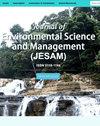Correlation Studies of Arsenic Level In Drinking Water and Blood Samples of Females in District Sheikhupura, Pakistan
IF 0.3
4区 环境科学与生态学
Q4 ENVIRONMENTAL SCIENCES
引用次数: 4
Abstract
Arsenic contamination of drinking water has become a major health concern all over the world. Pakistan is also facing an arsenic contamination in drinking water. The present study determine the correlation of arsenic level in drinking water and blood sample of females of District Sheikhupura, Pakistan. The study area for the present research work is District Sheikhupura, which is an industrial as well as an agricultural city in the province of Punjab, Pakistan. The arsenic concentration in drinking water from different sources used by the inhabitants and blood samples of females was measured by using Atomic Absorption Spectrophotometer (AAS). The drinking water of tehsils Sheikhupura and Sharaqpur had higher arsenic as compared to other tehsils (64.25 ± 2.55 μg L-1 and 61.63 ± 2.73 μg L-1) respectively, and was highest in all hands pumping water (71.14 ± 2.6μg L-1). Mean arsenic concentration in blood samples was highest in the age group of 23-25 years (3.2 ± 0.23 μg L-1) and being highest among respondents of tehsil Sheikhupura. A positive correlation between drinking water and blood samples when analyzed with respect to area and drinking water sources was found. Evidences suggest that the presence of arsenic in drinking water is likely to affect general metabolism and its accumulation in human. This appears to be linked with exposure of varying magnitude and duration.巴基斯坦Sheikhupura地区饮用水中砷含量与女性血液样本的相关性研究
饮用水中的砷污染已成为全世界关注的主要健康问题。巴基斯坦还面临饮用水中的砷污染。本研究测定了巴基斯坦Sheikhupura地区女性饮用水中砷含量与血液样本的相关性。本研究工作的研究区域是Sheikhupura区,这是巴基斯坦旁遮普省的一个工业和农业城市。采用原子吸收分光光度计(AAS)测定了居民饮用水和女性血液样品中砷的浓度。Sheikhupura和Sharaqpur两个县的饮用水砷含量分别高于其他县(64.25±2.55μg L-1和61.63±2.73μg L-1),并且在所有抽水手中砷含量最高(71.14±2.6μgL-1)。血液样本中的平均砷浓度在23-25岁年龄组最高(3.2±0.23μg L-1),在Sheikhupura县的受访者中最高。在对区域和饮用水源进行分析时,发现饮用水和血液样本之间呈正相关。有证据表明,饮用水中砷的存在可能会影响人体的一般代谢及其积累。这似乎与不同程度和持续时间的暴露有关。
本文章由计算机程序翻译,如有差异,请以英文原文为准。
求助全文
约1分钟内获得全文
求助全文
来源期刊

Journal of Environmental Science and Management
ENVIRONMENTAL SCIENCES-
CiteScore
0.90
自引率
0.00%
发文量
10
审稿时长
2 months
期刊介绍:
The Journal of Environmental Science and Management (JESAM) is an international scientific journal produced semi-annually by the University of the Philippines Los Baños (UPLB).
JESAM gives particular premium to manuscript submissions that employ integrated methods resulting to analyses that provide new insights in environmental science, particularly in the areas of:
environmental planning and management;
protected areas development, planning, and management;
community-based resources management;
environmental chemistry and toxicology;
environmental restoration;
social theory and environment; and
environmental security and management.
 求助内容:
求助内容: 应助结果提醒方式:
应助结果提醒方式:


